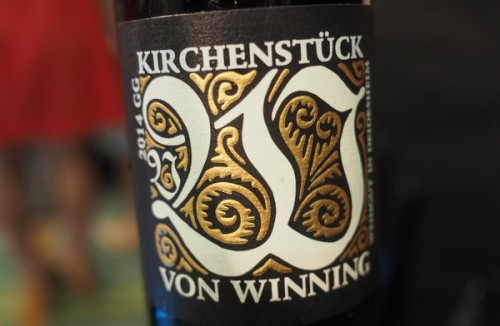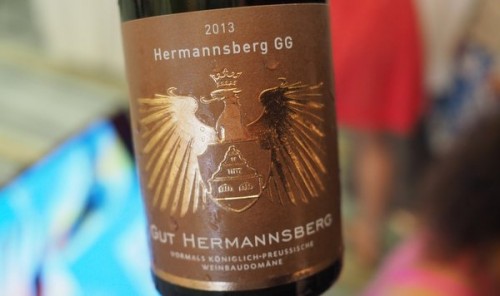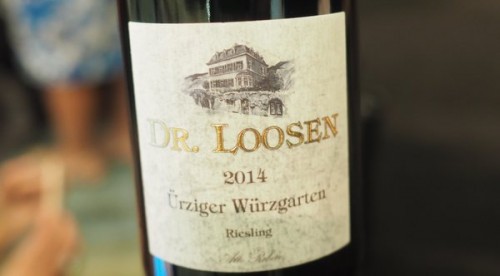
This TexSom tasting focused on Grosses Gewächs: these are wines produced from top vineyard sites in Germany by members of a high-end producers club called the VDP, which began life in 1910. As with all things to do with German wine, things are complicated, and explaining the details of how the VDP’s vineyard classification isn’t a simple business.
VDP stands for Verband deutscher Prädikatsweingüter (which translates as the Association of German Superior Quality Wine Estates). Fortunately, it’s simply abbreviated as VDP. There are around 200 members (you get invited to join after expressing an initial interest), and each member is reevaluated every five year. It’s an elite grouping when you consider that Germany has 30 000 winegrowers.
The whole point of the VDP is grading terroirs, with a view to recognizing the best. Since a revision in 2012, vineyards are classified on four levels:
- VDP Grosse Lage (equivalent to Grand Cru)
- VDP Erste Lage (premier cru)
- VDP Ortswein (village level)
- VDP Gutsein (regional)
Only the first two tiers are allowed to mention the vineyard name on the label. So a Grosses Gewächs (GG) is a top wine made from a Grosse Lage by a member of the VDP. These wines have to be dry (under 9 g/l residual sugar), and they are the wines we tasted in Wiesbaden. There’s one more layer of complexity: for each region, only certain varieties can make GG wines. If you see GG on a bottle, then you know it is pretty serious, and that it’s made in a dry style (trocken) from a top vineyard site.
In some ways, this classification is an attempt to recover what was lost with the German wine law of 1971, and amalgamated 30 000 sites and consolidated them into 3000 accepted vineyards. At this time, quality was defined by must weight. This lost a lot of the differentiation of interesting terroirs.
Gutswein is high calibre entry level wines and come from an estate’s holdings. Ortswein comes from the villages best vineyards, but ones that aren’t higher graded. Other varieties can be used. Erste Lage comes from a premier cru vineyard as designated on the old maps. Maximum yield is 60 hl/ha, and only traditional varieties are allowed. The Ahr, Mittelhein, Mosel, Nahe and Rheinhessen don’t use this classification. They go from Orswein to Grosse Lage. Grosse Lage is grand cru equivalent, with traditional varieties and maximum yield of 50 hl/ha. VDP Grosses Gewãchs is the name for a dry wine from this site, and each producer can only produce one GG from each site.
To illustrate how confusing German wine can be, one of the wines included in this tasting labelled in the tasting sheet as a Grosses Gewächs actually isn’t. Louis Guntrum in the Rheinhessen isn’t a member of the VDP. But owner Konstantin Guntrum thinks his Hipping holdings are GG standard, so he trademarked the name ‘Louis Guntrum Grosses Gewächs’ which he uses on the label. It’s a subtle and naughty move that even confused the organizers of this tasting.
THE WINES
Rainer Sauer Silvaner Escherndorfer Lumpen 1655 GG Sylvaner 2014 Franken, Germany
Lovely stuff. A bit saline and very mineral with a nettley, herby edge to the citrus fruit. Has a lovely texture: quite stony and mineral with nice precision and a salty finish. 92/100

Gut Hermannsberg Riesling Niederhauser Hermannsberg GG 2013 Nahe, Germany
This is a monopole. Beautifully floral with aromatic citrus fruit. The palate is linear with really complex, detailed, midweight citrus fruit. It has lovely precision and keen acidity, but it integrates so well into the wine. Has a lovely stony mineral quality, too. There’s a roundness to the fruit, even though there’s high acidity. 94/100
Louis Guntrum Riesling Niersteiner-Hipping Louis Guntrum Grosses Gewachs 2012 Rheinhessen, Germany
Note: this isn’t a VDP GG. Good concentration and quite a deep colour. Some herbs and a hint of petrol, showing some development to the melon, pear and ripe apple fruit. A bold, rich style, showing a bit of development. 90/100
Clemens Busch Riesling Pündericher Marienburg GG 2013 Mosel, Germany
Lovely intensity here with compact, dense citrus fruits and a keen, stony minerality, good acidity and a touch of honeyed richness, as well as a hint of cream. Really vital and intense with a touch of sweetness and lively acidity. A lovely wine. 94/100

Dr Loosen Riesling Urziger Würzgarten Alte Reben GG 2014 Mosel, Germany
This has lovely concentration of powerful but elegant citrus and ripe melon fruit. There’s some richness here with an alluring, fruit-driven palate with good acidity really well integrated, and a bit of sweetness (9 g/l residual sugar). It’s fruity and delicious, but also serious at the same time. Generous and fine. 95/100
Eugen Müller Riesling Spätlese Trocken Forster Kirchenstück ‘Cyriakus’ 2014 Pfalz, Germany
This isn’t a Grosses Gewachs because Müller isn’t a VDP member. Supple, dry and fresh with pure citrus fruit. Nicely textured with a linear lemony drive. It’s very pure and quite mineral with a faint hint of smokiness and mintiness. Lovely tension here. 92/100
Von Winning Riesling Forster Kirchenstück GG 2014 Pfalz, Germany
Fresh and linear with a lovely lemony undercurrent to the palate, which has some melon and pear richness, as well as some apple notes. Lovely acidity here with a bit of warm spiciness hiding in the background. Lovely density here with a lingering lemony finish. 93/100

Robert Weil Riesling Kiedricher Gräfenberg GG 2015 Rheingau, Germany
Really intense, fresh, dry and with high acidity (8.3 g/l), and lovely linear lemon and grapefruit characters. There’s a wonderful mineral core to this wine dancing in and out of the concentrated citrus fruit and the faint hints of lanolin and spice. Very fine and expressive. 94/100
Find these wines with wine-searcher.com
Leave a Comment on Texsom: Germany’s finest – VDP Grosses Gewächs